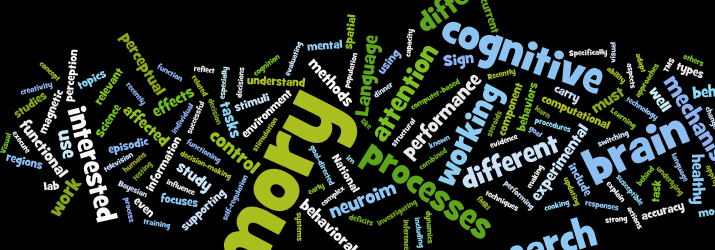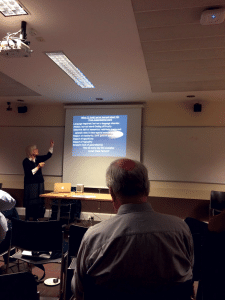

On 4th December, the ABN special interest group for cognitive disorders met at Imperial College London for an afternoon of talks, debate and catching up with like-minded clinicians. It was well attended by both senior and junior neurologists, albeit with a bias towards those based in the south of England. A format of twenty-minute talks, as well as a striking variety of presentations from proof-of-concept proposals through to summaries of a career’s work, proved effective in preventing attention from sagging.
Localisation of function in the brain has traditionally focused on the roles of individual brain areas in specific activities. Modern functional imaging research has started to analyse patterns of activation across the brain, networks which relate to generic states of brain activity across tasks. Prof Richard Wise and Fatemeh Geranmayeh (Imperial College) discussed the roles of three of these in language recovery after stroke: the default-mode network which is deactivated during specific tasks, the right and left fronto-temporo-parietal networks which are active in sustained attention, and the cingulo-opercular network which is active in processing multiple cognitive demands and the salience of stimuli. They proposed that speech therapy has been too narrowly focused on language, and should also engage aspects of the networks which support re-learning in general.
Continuing the theme of differential activation of networks in different kinds of task, Kanch Sharma (Bristol) drew our attention to the roles of amine neurotransmitters. Noting that the dopamine system is active in tasks requiring divided attention and executive control, and that caffeine acts primarily through the dopamine system, he presented a series of experiments investigating the effect of caffeine on executive and attentional tasks in healthy people. There were some interesting dissociations between tasks which will be well worth following up.
Updated criteria for Alzheimer’s disease include biomarkers to add certainty to diagnosis. Amyloid PET ligands have recently become available for diagnostic use, and are now licensed in the UK. Alternatives included CSF examination for amyloid and tau. Biomarkers are not required for the vast majority of individuals with suspected Alzheimer’s disease. Chris Carswell (London) described the first fifty patients who have been scanned using florbetapir at Charing Cross Hospital. This included patients who had previously had CSF biomarkers. There was not 100% concordance between florbetapir PET imaging and CSF results. The presented data suggested that amyloid PET imaging has a role in particularly difficult/atypical cases, especially young onset, but should be implemented using a multi-specialty MDT approach. Further research is required on how best to implement biomarker detection for improving AD diagnosis in routine clinical practice.
Dan Blackburn (Sheffield) sparked an interesting debate on the subject of functional cognitive disorders. His survey of cognitive neurologists revealed a lack of consensus on how the concept should be defined, or even whether it was a useful one at all; some audience members argued that we give a ‘functional’ label to medically unexplained symptoms in other fields, and a clear diagnosis helps the patient; others felt that these symptoms were different in nature from other functional neurological disorders, and indeed medicalising them at all might not be the right thing to do. He went on to discuss the role of conversation analysis, and in particular looking at the approaches patients take to describing their problems in the consultation. There is evidence that this is a useful approach in differentially diagnosing pseudoseizures from epilepsy, and Dan presented evidence that it may also be useful in the cognitive clinic.
Apathy is a major problem for people with neurological disorders, and for their carers. In Parkinson’s disease, reduced motivation can be seen separately from depression (and is different from the apathy without distress which occurs for example in fronto-temporal dementia). Kinan Muhammed from Oxford described an interesting approach to this, using the fact that the expectation and experience of reward cause consistent changes in pupil size. He has found that this response is smaller in people with Parkinson’s disease who report apathy, but not in those without apathy, and that this is mitigated by dopaminergic medication, suggesting that these patients’ lack of motivation may be related to a reduced sensitivity to reward.
Peter Jenkins (Imperial College) suggested that damage to the dopaminergic system might contribute to cognitive impairment following traumatic brain injury (TBI): typical impairments include executive function, attention and cognitive speed, all of which are modulated by dopamine, and dopaminergic nuclei and tracts are often damaged by TBI (as shown by volumetric MRI, diffusion MRI and DaTscan). He made a convincing prima facie case for testing dopaminergic treatments to relieve post-TBI cognitive dysfunction. Those who use neuropsychological tests will also find it interesting that his subjects engaged enthusiastically with tests on a tablet computer which they undertook at home in their own time, and on the other hand that repeated administration of the tests could avoid an alarming degree of test-test unreliability.
The common neurodegenerative diseases have the unusual property of being only weakly heritable except for a small proportion of cases associated with single dominant gene mutations. Jon Rohrer (Institute of Neurology) gave an update on the progress of the GENFI collaboration, an international database of patients with fronto-temporal dementia due to mutations in MAPT, GRN or C9ORF72. This promises to be a valuable resource for understanding these conditions and how they relate to their sporadic counterparts.
Cerebrovascular disease is an important cause of cognitive impairment, and no known medical treatment can relieve the symptoms. Mathilde Pauls (St George’s) plans a proof-of-concept study using a single dose of a phosphodiesterase type 5 inhibitor (tadalafil) to try to increase cerebral perfusion in those with vascular cognitive impairment, using MRI with arterial spin labelling to measure the outcome. There was some debate over whether ongoing hypoperfusion really contributes to vascular cognitive impairment; cognitive tests are also planned as part of the study, so the question will be addressed empirically.
The climax of the afternoon was Prof Karalyn Patterson’s explanation of the clinical and neuropsychological features of semantic dementia, a condition which we have gradually come to understand over the last forty years – in significant part thanks to her own hard work and insight – and which has revolutionised our understanding both of what semantic memory is and of how the brain achieves it. Through clinical vignettes, Prof Patterson illustrated the way the condition attacks conceptual understanding in a way which is both uniform across individuals and remarkably specific: patients can recall events, navigate complex routes and enjoy sudoku, while at the same time they may hold an umbrella closed over their head, ask why the horse (actually zebra) has stripes, and draw a peacock with four legs. Perhaps most strikingly, two patients used unusual words in conversation (‘petroleum’, ‘euphoric’) but were baffled when five minutes later they were asked what that word meant.
The meeting was enthusiastically received; we hope that future meetings will keep up this standard, and if so they will be of interest to those with an interest in neurodegenerative diseases as a whole, not just their cognitive presentations.
ACNR 2015;16(2):22. Published online 14/6/16
To Cite: Knibb J, Malhotra P, Blackburn D. ACNR 2016; 16 (1)